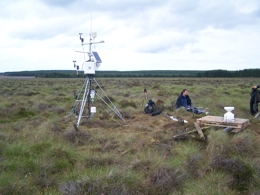
 |
 |
Current work The beginning of August in 2010 was a prolonged dry period, with average hourly temperatures reaching 24 degrees C, from the 2nd to the 12th August. Thereafter 28.2mm of rainfall fell over 5 days. This two-three week period shows the drawdown of peat water tables under dry conditions falling 10 cm over the 8 days, but the rainfall encouraged a 25 cm rise, which was almost to the peat surface. The behaviour of water flows in two of the gauged streams is particularly interesting, shown below. Grain Beck drains the afforested sector of May Moss and is cut by drainage ditches and covered by a mixture of cleared and intact forest. The water flows are continuous with small increases during the rainfall. The other system, Little Grain, dries up during the dry period withno flow over the weir, in fact the water level variations are more akin to the water table curve on May Moss. Little Grain drains the southward flows from May Moss and on leaving the bog is a forested peat-bedded stream to the gauging point. From the 4th August, the complete set up was installed on May Moss, with the full four height mast array, three dip well sites and four gauging stations all running in parallel. Please visit here in the future for updates on changes at May Moss SSSI. |
 |